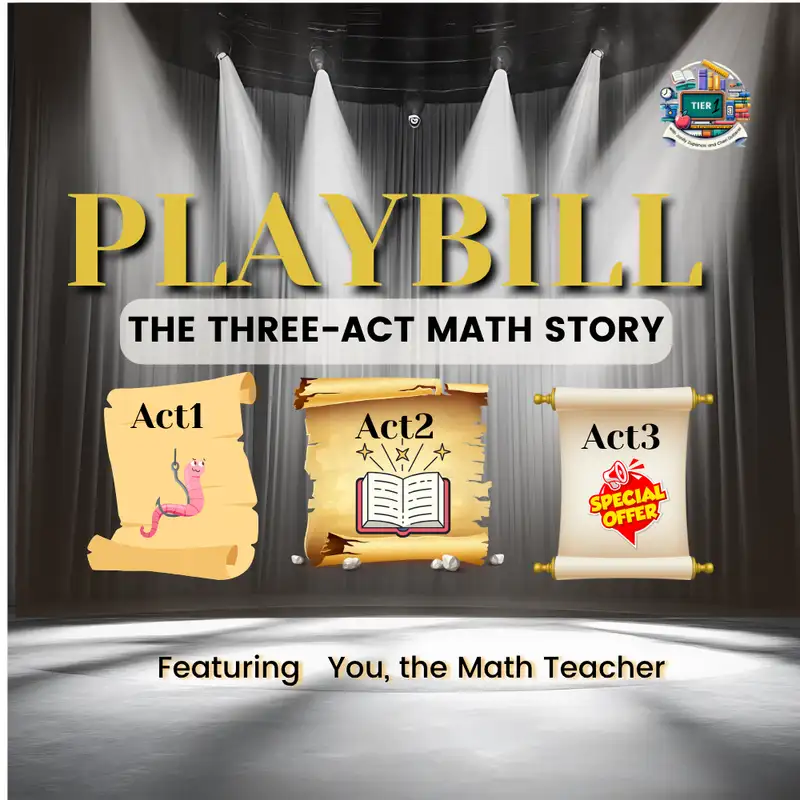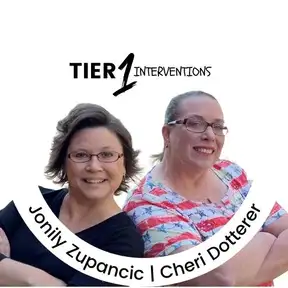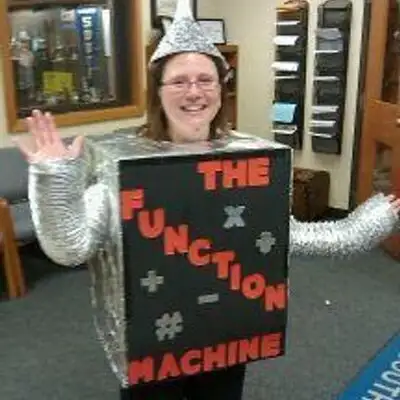
Teach Math Like a Play
T1I August 2025 Segment 5: Storytelling
===
Jonily: [00:00:00] Hey everybody, it's Cheri Dotterer here at Tier One Interventions podcast.
I'm here today with Jonily Zupancic and we are in class today with a live group of ladies and gentlemen who are learning about the Mastery Math method. So I'm gonna let Jonily talk and if there's any intervention that I wanna add to the puzzle, we will do but for now, I'm signing it all over to Jonily and let us learn a little bit about mathematics.
Girl. Y'all, this is Jay-Z. I'm Jonily Zupancic, I'm your math specialist, your main Mathineer. I if you are listening to this podcast or you're watching this podcast on YouTube I want to give a disclaimer and a warning. This is level two. You're listening in on a level two version of Mastery Math method.
So by the time kids are in middle school, they're like, they have subconsciously said, they may not even realize what they're saying to themselves, but they're saying to themselves, if I just sit [00:01:00] back and do nothing, someone else is gonna answer the question. And if another student doesn't answer the question, the teacher will.
So by the end of class, sometimes within 30 seconds, somebody's going to answer the question for them. So they have been trained to not think we've done this to them. It is not the student's fault. Thoughts, comments, questions on that?
Kirk: You were right.
Jonily: Is that all you were right for now?
Kirk: Yes. That's all. She's right.
Jonily: Cheri, you are the master of neuroscience. Do you have any connections to make with that? I, oh, Kirk just makes me laugh. Sorry. I got [00:02:00] distracted by the chuckle inside.
Think about Shakespeare for a moment. Shakespeare had the what? Three Act play. Isn't he the one that was famous for the three act play? Krista's thinking, come on, you guys did it excel in literature? I No. Totally get that. We're totally get that. Cheri, I dunno anything about literature, I don't know anything about literature either.
But think about the three act play. If you resolve the problem in act one, there's no need for Act three.
Holy
four,
you gotta watch it.
I just said fart.[00:03:00]
So Dan Meyer also created many, and this connects to what Cheri said about the plays three math tasks. Look this up. It went viral years ago before viral even existed. Three act math, the number three, three Act math. It's the exact math version of what Cheri's talking about with plays. Think about a book.
If you read a fiction book. I think fiction is the not real. Okay. I just, guys, I struggle with anything but math. I'm good at math. So think about if you read a chapter book, there's 12 chapters. If we answer all the questions, just like Cheri said in chapter two, why would I read chapter three?
This is how we want you to teach math. The mastery math method is [00:04:00] exactly that. Exactly that Krista has a favorite three act Math. It's the rope jumper. I've never seen that one. If you're listening to this, look it up. The rope jumper Natalie. One strategy to bring back when they don't have anything to say is to have the oh, Natalie, wait a minute.
Wait a minute. Good teaching here. So Natalie says, one strategy to bring them back when they don't have anything to say. So when you prompt and there's silence, is to have them restate in their own words or add on to what someone else said. Natalie, this is profound. This is absolutely beautiful, and I will do this a lot.
So if Jenny said something earlier and then I'm asking something and nobody says anything, I will use my favorite three words. Tell me about, okay guys, this is awkward, da. All I want you to do right now is tell me about what Jenny said. Tell me what Jenny said because all I want them to do is to speak, even if they're paraphrasing or replicating.
Natalie. Fantastic. What [00:05:00] do you call that, Natalie? We're gonna coin this for you. What can we name Okay, Natalie, think about this. 'cause I want this to be yours. This is gonna be Natalie's strategy. When a student restates in their own words what someone else has said, Natalie, we need a name for that.
You have to name it and we're gonna call it the Natalie strategy, and it's gonna have a name. And Cheri and I teach on focus triggers. Okay. Focus triggers. What I've just talked about, what Natalie just gave an example of is an example of a focus trigger. So Natalie, you're gonna name your focus trigger.
And the definition of your focus trigger is gonna be when you prompt and you wait, you give wait time, still, nobody responds. What do we do next? As an educator, your strategy is to have them restate in their own words what someone else has said. And Natalie, you're gonna name that and it's gonna be one of our named focus triggers.
Natalie: I just think of it as how you everyone can notice something. Everyone can contribute too. Like I'm not [00:06:00] asking you to have the answer, but you're part of the conversation. I don't know if that names it, but that's just the thinking. Like everyone has, everyone can be part of this, whether you have something to say or not, or, and then that just snowballs the conversation from there as people continue to add on.
But you can't just sit there and not be part of it. 'cause you can do that. Everyone can restate.
Jonily: And this is a really, this is another important component of the mastery math method. And that is when I lost my train of thought, but I'm gonna get it back. 'cause Natalie said, and the restate and the everybody can contribute, blah, blah, blah.
I got it. Okay. So leveling the playing field, that's what I was thinking. And then it went in and out of my brain so quickly. I had to retrieve it again, leveling the playing field. If our priority is always answer, getting and solving as it should not be. But if our priority is answer, getting and solving, we always have kids [00:07:00] who can and kids who can't.
We've already polarized our classroom. If the priority is answer getting and solving, we are creating strong polarization of our students. We have kids that can and kids that can't, and a whole continuum of kids in the middle. But if we focus on thinking reasoning and sense making, and this goes to Natalie's point.
Everybody can tell me about everybody. Everybody can notice, everybody can do these things. So it levels the playing field. We're all on the same playing field before we start answer, getting and solving. Go ahead Cheri. You're showing us something.
Teresa: Oh yeah.
Jonily: Mute.
Oh, she's muted. She's saying wonderful words and we can't hear words. I You can't hear her. I [00:08:00] can see them. I can feel the energy for your mutation. I'm so sorry. Mute Cheri. Remove the mute. Okay. This is from our masterclass on Wednesday night, and this is a direct quote from something Amy said last year while we were recording Level one Mastery Math Method.
And she said, one of the things I like about the Mastery Math Method is what I love is every kid has an entry point. That's exactly what we're talking about here. Every kid can contribute. It's the same thing that happens when we're looking at dyslexia instruction. It benefits all the kids are benefiting from what they're teaching with a dyslexia mastery Math method is the way to get that same effect in mathematics.
Teresa: Well, Jonily, you always say, tell me what tell me what about, what did you hear? [00:09:00] Because you are just restating it. So instead of, what did you see or tell me about, what did you hear?
Jonily: We go, Theresa Teresa, right now. What did you just hear? Theresa's prime, prompt. We need to make a list of prime prompts because, and
Teresa: she just, but it's Natalie's what did you just hear?
Repeat what you just heard. You don't have to say anything else. Just tell me what you just heard. Something like that. Repeat what you heard. And
Hey everybody, it's Cheri again. If you're loving these strategies and you want to join our Mastery Math Method Masterclass, we hold this hour long event once a month and we'd love to have you join. What we talk about there is how to improve your math skills in 10 days. Can you imagine 10 days, whether you are a math teacher or an occupational therapist, you can see exactly how to shift teaching so that every student, no matter their starting point, can master [00:10:00] core math concepts and reserve.
So reserve your seat today and go over to disability labs.com/calendar to check out the next event.
Jonily: so what is one word, and we don't have to answer this now, but what is one word? Like for example, there is a book and I got this as a new teacher at this new district I'm partnering with this year that I'm teaching in the classroom for a few classes.
We got the book Teach Like a Champion. So if you've ever heard the book Teach Like A Champion, if you haven't, look it up. But it's been out for years and years. Multiple versions teach like a champion has certain things systems and processes that are in place to create high productivity in schools.
And one of the strategies and teach like a champion is called track. So I used this in my classroom last week as a matter of fact. So I had a student sharing something and there were some side conversations. So I [00:11:00] stopped everybody and I said, Hey, we're gonna learn this strategy. And what this means is when a student is talking, you're gonna track them.
So I'm gonna say track anally. And so I'm telling the students, okay, so you need to focus and pay attention. When you track, that means you turn your body, you look at the person and teach like a champion. They use Spirit Fingers. You do that toward the person to show that you're tracking them.
So I said, okay, let's try this. So Anna Lee don't say anything else yet. You're gonna start over in a minute. Let's practice this. Okay. Track Annalee, boom, everybody turns and Anna Lee talks. Okay, my point is we want to create our own versions of that for math classroom. So what Natalie is describing it, so we want some like prompt points here.
So what Natalie is describing, we want one word to describe that, but Theresa. Theresa, what you just contributed is different. Like we're creating this as we go right now. So Theresa has [00:12:00] another prompt that we need to add to our list and that is, what did you hear? But that's not the same as the name of the strategy, which is gonna be Natalie's.
Okay. We're gonna extract all of this from our level two this year. Like we as level two group, we're going to create this and then all of you are gonna contribute and then all of you, your name is gonna be attached to your contribution because Cheri and I already have a bunch of focus triggers and things that we've named.
So now we have two more examples. We have another prompt for Theresa's credit. What did you hear? And then what's the strategy called? Credited to Natalie, and we'll name that.
Anything else?[00:13:00]
Okay. I think I want, I think I wanted to add something about storytelling. Oh, please, yes. In the world of marketing, one of the strategies, one of the key strategies to marketing whatever it is that you're trying to sell. Even you getting up in the morning and trying to sell your spouse on who gets to use the bathroom first.
Okay? So go as simple as that. But it can be as complex as somebody getting marketed to purchase mastery math method. Okay? There is always a story to tell. There's always a story to tell. And when I think about that three act play, we have the Russell Brunson model of hook story offer. How are we hooking our kids?
[00:14:00] What is the story that is behind the hook? And how are we offering to solve the solution to solve the problem to the story? Isn't that what mathematics is supposed to be doing? Is the hook story offer? When have we lost hook story offer in our way of delivering mathematics? Okay, here's another thing that I do in my classroom.
I just shared a teach like a champion strategy with track and use the spirit fingers. I don't have my, I teach high school, so I don't have my kids use the spirit fingers for the tracking from teach like a champion. The way that I use Spirit Fingers is an example that I'm gonna respond to what Cheri just said.
You all saw this. If and if you're watching this on the YouTube podcast, you saw me do this, I do spirit fingers up in the air. Okay? I used to be a cheerleader, okay? So I do spirit fingers if I'm loving what you're saying. So I don't have to say it out loud. I don't have to interrupt her thought.
I don't have to be obnoxious. So like the students in [00:15:00] my classroom, I'm training them right now. Like I absolutely loved what Cheri was saying. It was beautiful. I'm not even gonna repeat it because I can't even say it better than she did. But what I did in the background is I have spirit fingers up in the air, and that is the nonverbal quiet response.
And it, this is also creating the culture in my classroom. If you have spirit fingers, it may not mean that you agree, but oftentimes it also means there's a different symbol for agree. I don't know if some of you use this symbol with your thumb and your little finger. That's the universal educational sign that I agree with you, and you can use that too.
I agree with you, is different than, oh, I love what you're saying. Okay? So in my room, even with high schoolers, we will spirit finger if somebody's talking and you love what they're saying instead of verbally being obnoxious. And Cheri, spirit fingers, okay. [00:16:00] You are also doing a variation on clapping your hands if you are deaf, which is what I'll often do is I'll do this 'cause I that's clapping your hands if you are deaf.
Now Kirk, this is important. Kirk, you ask a very important question.
Kirk: I had a feeling it was I need to know,
Jonily: because here's the thing, Kirk, I was a cheerleader, so I'm gonna, I'm gonna give you this analogy. I was a cheerleader. Hold on, stop one moment. This, the comment from Kirk was, what is the difference between spirit fingers and jazz hands?
I need a tutorial. So for the people in the audience who didn't get that's what Jonily is answering right now. So I was a cheerleader and spirit fingers are like here. If I do this with my screen, spirit fingers are like way up in the air. Okay? Because it's woo okay. It's oh [00:17:00] my God, okay.
If I'm at a concert and I'm like, woo, spirit fingers, those are up in the air. Jazz hands are like the end of a statement mic drop. Okay, so let me stand up. Let me stand up. Because Kirk, here's the thing. I was a dancer growing up too. Being a dancer is different. Than being a cheerleader.
Okay. So there's a difference. You gotta know this difference. I can't move in this office. Okay? There's a difference between being a dancer and being a cheerleader. Okay? So being a dancer, you might do, da, and you're like, finished. And it's duh. Jazz hands are like the exclamation point on the statement.
Like I'm gonna be presenting something. And I'm trying to think of, I'm like off the top of my head. So like I say, oh here's something I say a lot. Okay? Improving number sense is not intervention [00:18:00] at the secondary level. Okay? I say this a lot, improving number sense is not intervention at the secondary level.
It's like regular instruction. So this is another paradigm shift da. And so I'll say that, I'll be like, I'll be in a presentation and I'll say improving number sense is not intervention at the secondary level. It's regular instruction. See, that's a jazz hand, okay? It's not a spirit finger. Okay? Let's, thank you for that, huh?
What'd you say? Thank you for that. You're welcome. You are welcome. You're welcome. So we gotta this is really emotional and personal, what we're doing and I don't even know what the end is anyway. I love you guys. Okay, so let's get back to the locker problem. [00:19:00] Remember we have math to do today. Natalie's like Jolie, I came here for the math. Can you just get back to the math?
Okay, I will. Natalie's spicy today
Natalie: I think I have three words, yes, if we're in class, okay, who can support, clarify, or repeat what so and so just said. I don't know if I can make that one word, but that's the strategy I got. Love it. That's what's brewing right now. Love it. Keep brewing.
Keep brewing. Keep
Jonily: brewing.
Okay, my lovely loves. All right, so student four is gonna come through. Now you notice what I did here when this is really explicit, direct instruction, what I did on the locker problem. And then I do a lot of responsive teaching, which I actually just modeled here with all of you adults. But this is how I want you to do it in your classroom.
You just saw direct explicit instruction. When we all have the locker game board, we're taking [00:20:00] notes. It's different than the way math notes usually look, but this is an example. When I'm putting the numbers in the locker spaces and I'm having kids mimic that and model me and copy me. This is explicit direct instruction.
This is different than what you might think of as explicit direct instruction, but this is how a reference task is used for explicit direct instruction. But then we went way off on this tangent that had nothing to do with this, but it had everything to do with this. We think those tangents we go on are wasting time.
So we don't do them in the classroom because we have to focus on the mathematics. But what we're not understanding is what we think of as wasting everything that I just did before I came back to the explicit direct instruction, which is ad-lib, which was like on the spot, which was responsive. Teaching is absolutely necessary in our math classrooms, and we fear it, so we don't do [00:21:00] it, but I'm telling you, it's the thing that is missing.
So the reason we do explicit direct instruction is so that we can have these tangents, then we can come back because those tangents are when the best learning is created. This is what the flavor of instruction is in the mastery math method. We're modeling this for you right now. Everything I'm doing with you, I want you to do with your kids.
So yes, we're still teaching standards, we're still doing direct explicit instruction, but in between those times, we're doing bursts of conceptual, experiential, contextual storytelling.
Cedric: And speaking of perseverance, what happens when we tackle one of the hardest skills for students double-digit multiplication? In our next episode, we’ll [00:22:00] show you brain-based ways to teach it without tears or frustration."
Until then, remember. every student deserves the chance to see themselves as a mathematician. And as Cheri and Jonily say, Go Be Awesome! Go Be Brilliant! For you were put here for such a time as this.
Episode Video
Creators and Guests


